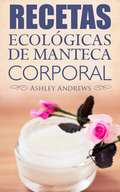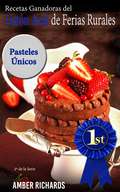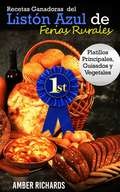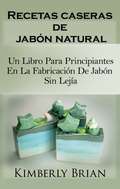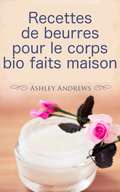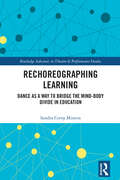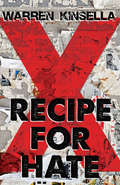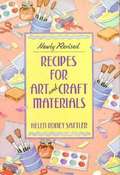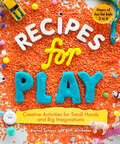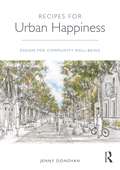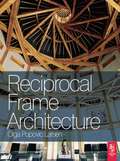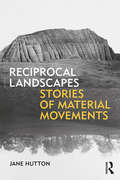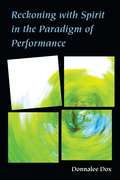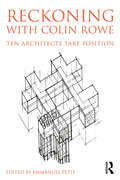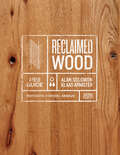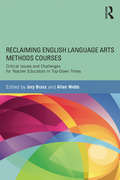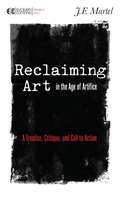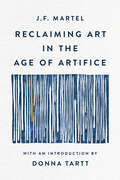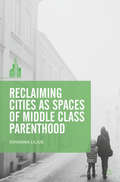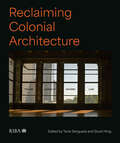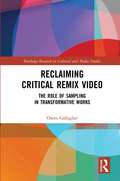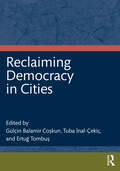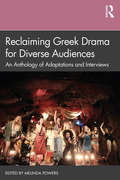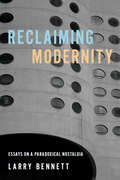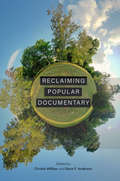- Table View
- List View
Recetas Ecológicas De Manteca Corporal
by Cristina Fernández Redondo Ashley AndrewsHidrata y nutre tu cuerpo con estas recetas caseras de manteca corporal. No hay nada comparable a la sensación de aplicarse sobre la piel una manteca corporal suave y nutritiva tras un baño caliente. La manteca corporal, con su consistencia de nata montada y su suave fragancia, lleva años nutriendo nuestros cuerpos resecos y cansados. ¿Qué hace de la manteca corporal un lujo para la piel? ¿De qué ingredientes se compone? ¿Es la manteca corporal de las droguerías diferente a la casera? Y por último, aunque no menos importante, ¿podemos preparar una manteca corporal segura y repleta de beneficios en la comodidad de nuestra cocina? Incluye 30 recetas de mantecas corporales En Recetas ecológicas de manteca corporal encontrarás las respuestas a estas preguntas para conocer los ingredientes, los usos y los beneficios de la manteca corporal. Además, se incluye una lista exhaustiva con recetas sencillas de manteca corporal con las que podrás empezar hoy mismo a crear tus propias mantecas saludables y libres de conservantes. Esto es solo un ejemplo de lo que aprenderás: · Qué es la manteca corporal · Para qué deberías usar la manteca corporal · Cómo y dónde aplicar exactamente la manteca corporal · Las diferencias entre las mantecas corporales comerciales y caseras · Apuntes de seguridad muy importantes si planeas crear tus propias mantecas corporales · Instrucciones paso a paso sobre cómo crear 30 mantecas corporales diferentes Aprenderás cómo hacer estas magníficas mantecas corporales, entre otras... 1. Manteca corporal de naranja silvestre 2. Manteca corporal batida de coco y ciruela 3. Manteca corporal batida de lima con aceite de coco 4. Manteca corporal de mango 5. Manteca corporal cítrica
Recetas Ganadoras del Listón Azul de Ferias Rurales: Pasteles Únicos
by Amber Richards David Arieta GalvánPrepara los pasteles ganadores en tu propia casa para la familia y amigos. Lleno de recetas caseras, auténticas y comprobadas que estremecerán tu paladar y que resultan perfectas en cada ocasión. Recetas Ganadoras del Listón Azul serán los nuevos recetarios esenciales en tu colección. Cada receta fue recolectada de los ganadores del listón azul o primer lugar en ferias rurales y estatales a lo largo del país. Impresionaron a los jueces; ¡ahora impresionarán a tus amigos! Más de 50 deliciosas recetas llenan este libro con pasteles únicos que seguramente serán un éxito. Prueba estas recetas de pasteles los cuales solo se convertirán en los favoritos de la familia y algo que estarás orgulloso de llevar a fiestas y reuniones. Pero ten cuidado, puedes llegar a ser "conocido" por tu pastel especial. Hay cupcakes, panqués, bizcochos y mucho más por descubrir. Si estás buscando meter un pastel a una competencia en una feria local, considera utilizar alguna de estas recetas comprobadas. Colecciona todos los recetarios de esta serie para comida buena en verdad. Desde pays hasta ensaladas, de dulces postres a guisados y de galletas a platillos principales, ¡puedes cocinar como un ganador del listón azul! Este es el segundo libro de la serie, obtén el tuyo ahora.
Recetas Ganadoras del Listón Azul de Ferias Rurales: Platillos Principales, Guisados y Vegetales
by Amber Richards David Arieta GalvánPrepara la mejor comida galardonada en tu propia casa para la familia y amigos. Lleno de recetas auténticas, estilo casero y comprobado que estremecen al paladar, resultan perfectas para cada ocasión. Las Recetas Ganadoras del Listón Azul será el nuevo elemento esencial de tu colección de recetas. Las recetas fueron recolectadas de ganadores del listón azul o el primer lugar en ferias de condado y estatales a lo largo del país. Impresionaron a los jueces, ¡ahora impresionarán a tus amigos! Más de 100 deliciosas recetas llenan este libro de cocina con platillos principales, guisados, vegetales, ensaladas y sopas. Nunca te quedes sin ideas para la cena. Colecciona todos los libros de cocina de esta serie para una buena comida de verdad. Desde pays hasta ensaladas; de dulces postres a guisados y de galletas a platillos principales, ¡puedes cocinar como un ganador del listón azul! Este es el primer libro de la serie, consigue el tuyo ahora.
Recetas caseras de jabón natural: sino con aceites esenciales, hierbas y especias"
by Kimberly BrianUn libro para principiantes en la fabricación de jabón sin lejía sino con aceites esenciales, hierbas y especias. Elaborar jabones naturales caseros sin lejía sino con aceites esenciales Recetas de jabones naturales caseros ¡Disfrute de los beneficios para la salud de los jabones naturales caseros que garantizan una piel radiante, atractiva, tonificada y saludable! Acaba de ir a la tienda a comprar efectos personales, y cuando llega al estante del jabón ... todos son jabones hechos con sustancias sintéticas. Este libro es una guía para principiantes en "Recetas caseras de jabón natural: un libro para principiantes en la fabricación de jabón sin lejía, sino con aceites esenciales, hierbas y especias ". La fabricación de jabón es un oficio que tiene que ver con la creatividad. Este libro enseña cómo hacer jabón con ingredientes naturales y sin lejía. Todas las recetas están hechas de ingredientes naturales que incluyen aceite de oliva, aceite de durazno, aceite de espino amarillo y muchos otros aceites que tienden a nutrir, rejuvenecer y curar las arrugas en la piel. Otros beneficios de las recetas de jabón en el libro incluyen la limpieza de la piel, la eliminación de la sequedad y de la descamación de la piel. Tiene la libertad de explorar su creatividad con la lista en el libro ya que no estará usando lejía. Las recetas en este libro son para: Piel madura Piel seca Piel sensible Barras de jabón Lavado a mano ¡No busque más! Comience a cosechar los beneficios para la salud de los ingredientes orgánicos frescos. ¡Descargue su copia ahora y comience el viaje a tener su propio jabón casero natural sin lejía!
Recettes de beurres pour le corps bio faits maison
by Ashley Andrews Judith SamsonRegénérez et hydratez votre corps des pieds à la tête avec ces recettes de beurres pour le corps faits maison. Connaissez-vous cette délicieuse sensation d’appliquer un beurre pour le corps riche et nourrissant sur votre peau à la sortie d’un bain chaud ? D’une consistance de crème bien fouettée et avec une fragrance subtile et agréable, le beurre pour le corps est reconnu depuis longtemps pour ses propriétés nourrissantes et hydratantes envers notre peau sèche et terne. Qu’est-ce donc qui rend les beurres pour le corps si merveilleux pour notre peau ? De quels ingrédients consiste un beurre ? Quelles sont les différences entre un beurre pour le corps fait maison et un beurre du magasin ? Plus important encore, est-il possible de fabriquer notre propre beurre pour le corps dans le confort de notre cuisine ? Toutes ces questions seront explorées en détail dans ce livre. Vous pourrez mieux comprendre les divers ingrédients, utilisations et bénéfices des beurres pour le corps. Aussi, nous avons inclus une liste détaillée de recettes incroyablement simples qui vous donneront l’envie de créer dès aujourd’hui vos propres beurres pour le corps, exempts de tous agents de conservation ! Voici ce que vous apprendrez : · Qu’est-ce qu’un beurre pour le corps ? · Pourquoi utiliser un beurre pour le corps ? · Les diverses utilisations d’un beurre pour le corps · Les différences entre un beurre du magasin et un beurre fait maison · Des précautions de sécurité à connaître avant de vous lancer dans la création de vos beurres pour le corps · Des recettes expliquées en étapes pour faire 30 différents beurres pour le corps Voici quelques recettes que vous pourrez voir dans ce livre: 1. Beurre pour le corps à l’orange 2.
Rechoreographing Learning: Dance As a Way to Bridge the Mind-Body Divide in Education (Routledge Advances in Theatre & Performance Studies)
by Sandra Cerny MintonThis book addresses the mind-body dichotomy in movement and dance. This book includes a description of the often-forgotten kinesthetic sense, body awareness, somatic practices, body-based way of thinking, mental imagery, nonverbal communication, human empathy, and symbol systems, what occurs in the brain during learning, and why and how movement and dance should be part of school curricula. This exploration arguers that becoming more aware of bodily sensations serves as a basis for knowing, communicating, learning, and teaching through movement and dance. This book will be of great interest to scholars and students interested in teaching methodology and for courses in physical education, dance, and education.
Recipe for Hate
by Warren KinsellaHow a group of Portland, Maine, punks defeated a murderous gang of neo-Nazis. The X Gang is a group of punks led by the scarred, silent, and mostly unreadable Christopher X. His best friend, Kurt Blank, is a hulking and talented punk guitarist living in the closet. Sisters Patti and Betty Upchuck form the core of the feminist Punk Rock Virgins band, and are the closest to X and Kurt. Assorted hangers-on and young upstarts fill out the X Gang’s orbit: the Hot Nasties, the Social Blemishes, and even the legendary Joe Strummer of the Clash. Together, they’ve all but taken over Gary’s, an old biker bar. Then over one dark weekend, a bloody crime nearly brings it all to an end. Based on real events, Warren Kinsella tells the story of the X Gang’s punk lives — the community hall gigs, the antiracism rallies, the fanzines and poetry and art, and what happened after the brutal murders of two of their friends.
Recipes for Art and Craft Materials (2nd Edition)
by Helen Roney SattlerFrom the book jacket: Experience the fun and joy of starting from scratch with Helen Roney Sattler's newly revised top-seller,Recipes for Art and Craft Materials. With this book you can make: BROWN BREAD MODELING DOUGH [which is] Excellent for creating jewelry and holiday decorations. LIQUID RICE PASTE: Use it to make great collages [or mend torn pages]. MILK POSTER PAINT: Just the thing for painting scenery and murals. WATERCOLORS: Start with white vinegar, baking soda, and cornstarch. A perfect rainy-day project And Many more exciting craft recipes in this informative book. This is a must own copy for anyone with children, grandchildren, who is an artist on a budget, or someone who is a teacher, coach, scout leader, or anyone who needs quick and proven recipes for arts materials.
Recipes for Play: Creative Activities For Small Hands And Big Imaginations
by Rachel Sumner Ruth MitchenerMore than 35 activities and ideas that inspire children to explore the world around them. An important part of childhood is being curious and trying out new experiences. What do things taste, feel, smell, sound like? What happens when you add red to blue, mix earth with water, or drop a blob of paint from a great height? These childhood experiments are vital for development and provide hours of entertainment. Recipes for Play contains easy and inexpensive ideas for engaging your child’s senses. Many wonderful hours can be spent playing with natural ingredients found in your kitchen cupboard or backyard garden. Make your own face paint in minutes, whip up a batch of oozy slime, create clouds of color with rainbow rice, and so much more. Sisters Rachel Sumner and Ruth Mitchener have created Recipes for Play for parents and teachers—or anyone with a child in their life—who want to encourage tactile learning but don’t want their lives to be controlled by chaos. Each recipe has easy-to-follow instructions for setting up activities and simple steps for cleaning up once the fun is finished.
Recipes for Urban Happiness: Design for Community Well-being
by Jenny DonovanThe experiences we enjoy, endure, or miss out on are influenced by what our surroundings allow and invite us to do. Just like our food diet, our experience diet influences our health and so our chances of finding happiness and fulfilling our potential. A healthy experience diet offers inspiration, reassurance, delight, and play. It nurtures physical, cognitive, and emotional health, builds resilience, and fosters confidence and self-esteem. An unhealthy experience diet lacks these things and consigns people to lives diminished in quantity and quality. Recipes for Urban Happiness offers an innovative way of looking at the relationship between people and place and redefines what good urban design is. The book outlines what designers and non-designers can do to create urban places where nurturing behaviours are both possible and preferable. Recipes for Urban Happiness will be relevant to public health, community development, and design practitioners, as well as students and academics.
Reciprocal Frame Architecture
by Olga Popovic LarsenIn structural terms reciprocal frame structures are 'three dimensional assemblies of mutually supporting beams'. But behind this definition lie some breathtakingly beautiful and complex structures at the heart of buildings both ancient and modern. This new book explores the principles of these apparently simple structures and demonstrates how they can be used in the context of a modern building.Starting with historic designs by de Honnecourt, Da Vinci and Serlio, the book presents the wealth of possible RF morphologies, and investigates the geometrical, structural and practical design issues of reciprocal frames. The case studies look at stunning examples of reciprocal frame architecture that range from low environmental impact buildings and self built examples in the UK and USA, to the fascinating and elegant structures of the Puppet Theatre in Seiwa, Tokyo's Spinning House, Sukiya –Yu house, The Toyoson Stonemason museum and the Life Sciences Laboratory – Torikabuto in Japan.The book is designed to inform and inspire architects and structural engineers alike, and brings to life a structural system whose principles have been used for thousands of years.
Reciprocal Landscapes: Stories of Material Movements
by Jane HuttonHow are the far-away, invisible landscapes where materials come from related to the highly visible, urban landscapes where those same materials are installed? Reciprocal Landscapes: Stories of Material Movements traces five everyday landscape construction materials – fertilizer, stone, steel, trees, and wood – from seminal public landscapes in New York City, back to where they came from. Drawing from archival documents, photographs, and field trips, the author brings these two separate landscapes – the material’s source and the urban site where the material ended up – together, exploring themes of unequal ecological exchange, labor, and material flows. Each chapter follows a single material’s movement: guano from Peru that landed in Central Park in the 1860s, granite from Maine that paved Broadway in the 1890s, structural steel from Pittsburgh that restructured Riverside Park in the 1930s, London plane street trees grown on Rikers Island by incarcerated workers that were planted on Seventh Avenue north of Central Park in the 1950s, and the popular tropical hardwood, ipe, from northern Brazil installed in the High Line in the 2000s. Reciprocal Landscapes: Stories of Material Movements considers the social, political, and ecological entanglements of material practice, challenging readers to think of materials not as inert products but as continuous with land and the people that shape them, and to reimagine forms of construction in solidarity with people, other species, and landscapes elsewhere.
Reckoning With Spirit In The Paradigm Of Performance
by Donnalee DoxPerformance has become a paradigm for analyzing contemporary culture, a pattern that structures a particular view of human interaction and experience. Performance is also widely used to better understand how we express values and ideas, including religious beliefs. Reckoning with Spirit in the Paradigm of Performance asks how the sensibilities of religious experience, which many people call spirituality, shape people's performance. When we observe people performing words, dances, music, and rituals they consider sacred, what (if any) conclusions can we draw about their experiences from what we see, read, and hear? By analyzing performances of spirituality and what people experience as "spirit," this book adds a new dimension to the paradigm of performance. Rather than reducing the spiritual dimension to either biology or culture. Donnalee Dox asks what such experiences might have to offer a reasoned analysis of vernacular culture. The specific performances presented are meditative dance and shamanic drumming, including descriptions of these practices and exegesis of practitioners' writings on the nature of spiritual experience and performance. Book jacket.
Reckoning with Colin Rowe: Ten Architects Take Position
by Emmanuel PetitWhile the first half of the 20th century in architecture was, to a large extent, characterized by innovations in aesthetics (accompanied by succinct and polemical manifestoes), the post-war decades saw emerge a more refined and intellectual disciplinary framework that eventually metamorphosed into the highly theory-focused moment of the 'postmodern'. Colin Frederick Rowe (1920 - 1999) was a leader of this epistemic shift due to his aptitude to connect his historical and philosophical erudition to the visual analysis of architecture. This book unites ten different perspectives from architects whose lives and ideas intersected with Rowe’s, including: Robert Maxwell Anthony Vidler Peter Eisenman O. Mathias Ungers Léon Krier Rem Koolhaas Alan Colquhoun Robert Slutzky Bernhard Hoesli Bernard Tschumi With an introduction by Emmanuel Petit and a postscript by Jonah Rowen In their critical assessment of a key 20th century formalist, these renowned architects reflect on how their own positions came to diverge from Rowe’s. Reckoning with Colin Rowe is a thought-provoking discussion of key schools, places, concepts and people of architectural theory since the post-war years, illustrated with over forty beautiful black and white drawings and photographs.
Reclaimed Wood: A Field Guide
by Alan Solomon Klaas ArmsterThe first handbook on reclaimed wood, combining useful information, rich history, and home design ideas. Reclaimed wood is a gift from ancient forests and a versatile material. Our ancestors built their homes and barns, warehouses, and factories with white pine and oak from the Northeast and the Midwest, longleaf pine and cypress from the South, and Douglas fir and redwood from the Northwest. When we salvage these and other woods for new projects, we are strengthening our own roots.Reclaimed Wood: A Field Guide is the first complete visual survey of this valuable resource, with chapters on history, sources, and types of wood, reclamation, and practical information, and its use in modern architecture and design.
Reclaiming English Language Arts Methods Courses: Critical Issues and Challenges for Teacher Educators in Top-Down Times
by Allen Webb Jory BrassReclaiming English Language Arts Methods Courses showcases innovative work in teacher education that fosters teachers’ capacities as reflective practitioners and public intellectuals; extends traditional boundaries of methods courses on teaching the English language arts, literacy, children’s and young adult literature; and embodies democratic and critical politics that go beyond the reductive economic aims and traditional classroom practices sanctioned by educational policies and corporate educational reforms. Featuring leading and emerging scholars in English language arts teacher education, each chapter provides rich and concrete examples of elementary and secondary methods courses rooted in contemporary research and theory, on-line resources, and honest appraisals of the possibilities, tensions, and limits of doing teacher education differently in a top-down time of standards-based education, high-stakes testing, teacher assessment, and neoliberal education reforms. This book offers important resources and support for teacher educators and graduate students to explore alternative visions for aligning university methods courses with current trends in English and cultural studies, critical sociocultural literacy, new literacies and web 2.0 tools, and teaching the English language arts in multiethnic, multilingual, and underserved urban communities.
Reclaiming Art in the Age of Artifice
by J. F. MartelPart treatise, part critique, part call to action, Reclaiming Art in the Age of Artifice is a journey into the uncanny realities revealed to us in the great works of art of the past and present. Received opinion holds that art is culturally-determined and relative. We are told that whether a picture, a movement, a text, or sound qualifies as a "work of art" largely depends on social attitudes and convention. Drawing on examples ranging from Paleolithic cave paintings to modern pop music and building on the ideas of James Joyce, Oscar Wilde, Gilles Deleuze, Carl Jung, and others, J.F. Martel argues that art is an inborn human phenomenon that precedes the formation of culture and even society. Art is free of politics and ideology. Paradoxically, that is what makes it a force of liberation wherever it breaks through the trance of humdrum existence. Like the act of dreaming, artistic creation is fundamentally mysterious. It is a gift from beyond the field of the human, and it connects us with realities that, though normally unseen, are crucial components of a living world. While holding this to be true of authentic art, the author acknowledges the presence--overwhelming in our media-saturated age--of a false art that seeks not to liberate but to manipulate and control. Against this anti-artistic aesthetic force, which finds some of its most virulent manifestations in modern advertising, propaganda, and pornography, true art represents an effective line of defense. Martel argues that preserving artistic expression in the face of our contemporary hyper-aestheticism is essential to our own survival. Art is more than mere ornament or entertainment; it is a way, one leading to what is most profound in us. Reclaiming Art in the Age of Artifice places art alongside languages and the biosphere as a thing endangered by the onslaught of predatory capitalism, spectacle culture, and myopic technological progress. The book is essential reading for visual artists, musicians, writers, actors, dancers, filmmakers, and poets. It will also interest anyone who has ever been deeply moved by a work of art, and for all who seek a way out of the web of deception and vampiric diversion that the current world order has woven around us.From the Trade Paperback edition.
Reclaiming Art in the Age of Artifice
by J.F. MartelA compelling call to rediscover the transformative power of art in an age of distraction, coercion, and spectacle – featuring an introduction from Pulitzer Prize–winning author Donna Tartt In Reclaiming Art in the Age of Artifice, J. F. Martel offers a compelling and incisive meditation on the nature of art in a world dominated by invasive media, rampant consumer culture, and artificial intelligence. Drawing on a wide range of examples, from Paleolithic cave art to contemporary cinema, Martel argues that true art reveals the unseen forces shaping our existence—forces that transcend politics, technology, and even culture. In contrast to artifice, which seeks to manipulate or distract, authentic art calls us back to the essence of things, opening &“rifts&” onto the sublime and the weird and reconnecting us with the radical mystery at the heart of the world. Featuring an introduction by Pulitzer Prize–winning author Donna Tartt, this edition also includes a new afterword by the author, reflecting on the continued relevance of art in our increasingly mediated world.
Reclaiming Cities as Spaces of Middle Class Parenthood (The Contemporary City)
by Johanna LiliusFor nearly a century families have been out-migrating to suburbs and peri-urban areas. In this book, Johanna Lilius conceptualizes the relatively recent phenomenon of families choosing to live in the inner city. Drawing on a range of qualitative data, the book offers a holistic approach to simultaneously understanding changes within parenting practices and changes connected to city development. The book explains not only why families choose to stay in the inner city and how they use the city in their everyday lives, but also how families change the landscape of contemporary cities, and how the family is, and has been, perceived in urban planning and policy-making. The Nordic perspective provided by Lilius makes this book an important contribution in helping understand inner city change outside the Anglo-American context, and will appeal to an international audience.
Reclaiming Colonial Architecture
by Stuart King Tania SenguptaOur world is full of lands, cities, buildings and artefacts, many of which are deposits and residues of colonial times and, more pervasively, colonial processes. Reclaiming Colonial Architecture unpacks the built inheritances of colonialism and re-thinks how we might understand, narrate, intervene in or act upon them as architects.Offering historical background, unpacking key concepts and presenting thematically organised and multi-scalar urban and architectural case studies, this accessible publication showcases how legacies of colonialism are being dealt with in real-world instances. Case studies involve works and actions by built environment professionals such as architects and heritage practitioners, as well as community initiatives and activism.The book aims to build confidence in practitioners, students and communities grappling with a seemingly vast and complex terrain of debates and approaches around colonial landscapes, urban areas, buildings, monuments and material culture. It also aims to be a helpful resource for architecture schools or critical heritage studies departments and organisations. Its content will provide a point of departure for graduate student inquiry and its accessible nature will help introduce undergraduate students to the concepts and questions of colonial built-environments.
Reclaiming Critical Remix Video: The Role of Sampling in Transformative Works (Routledge Research in Cultural and Media Studies)
by Owen GallagherRemix is now considered by many to be a form of derivative work, but such generalizations have resulted in numerous non-commercial remixes being wrongfully accused of copyright infringement. Gallagher argues, however, that remix is a fundamentally transformative practice. The assumption that cultural works should be considered a form of private property is called into question in the digital age; thus, he proposes an alternative system to balance the economic interests of cultural producers with the ability of the public to engage with a growing intellectual commons of cultural works. Multimodal analyses of both remixed and non-remixed intertextual work, with a particular focus on examples of critical remix video, fuel the discussion, synthesizing a number of investigative methods including semiotic, rhetorical and ideological analysis.
Reclaiming Democracy in Cities
by Gülçin Balamir Coşkun Tuba İnal-Çekiç Ertuğ TombuşEffective urban governance is essential in responding to the challenges of inequality, migration, public health, housing, security, and climate change. Reclaiming Democracy in Cities frames the city as a political actor in its own right, exploring the city’s potential to develop deliberative and participatory practices which help inform innovative democratic solutions to modern day challenges.Bringing together expertise from an international selection of scholars from various fields, this book begins with three chapters which discuss the theoretical idea of the democratic city and the real-world applicability of such a model. Part II discusses new and innovative democratic practices at the local level and asks in what way these practices help us to rethink democratic politics, institutions, and mechanisms in order to move toward a more egalitarian, pluralist, and inclusive direction. Drawing on the Istanbul municipal elections and the Kurdish municipal experience, Part III focuses on the question of whether cities and local governments can lead to the emergence of strong democratic forces that oppose authoritarian regimes. Finally, Part IV discusses urban solidarity networks and collaborations at both the local level and beyond the nation, questioning whether urban solidarity networks and alliances with civil society or transnational city networks can create alternative ways of thinking about the city as a locus of democracy.This edited volume will appeal to academics, researchers, and advanced students in the fields of urban studies, particularly those with an interest in democratic theory; local democracy; participation and municipalities. It will also be relevant for practitioners of local governments, NGOs, and advocacy groups and activists working for solidarity networks between cities.
Reclaiming Greek Drama for Diverse Audiences: An Anthology of Adaptations and Interviews
by Melinda PowersReclaiming Greek Drama for Diverse Audiences features the work of Native-American, African-American, Asian-American, Latinx, and LGBTQ theatre artists who engage with social justice issues in seven adaptations of Sophocles’ Antigone, Euripides’ Trojan Women, Hippolytus, Bacchae, Alcestis, and Aristophanes’ Frogs, as well as a work inspired by the myth of the Fates. Performed between 1989 and 2017 in small theatres across the US, these contemporary works raise awareness about the trafficking of Native-American women, marriage equality, gender justice, women’s empowerment, the social stigma surrounding HIV, immigration policy, and the plight of undocumented workers. The accompanying interviews provide a fascinating insight into the plays, the artists’ inspiration for them, and the importance of studying classics in the college classroom. Readers will benefit from an introduction that discusses practical ways to teach the adaptations, ideas for assignments, and the contextualization of the works within the history of classical reception. Serving as a key resource on incorporating diversity into the teaching of canonical texts for Classics, English, Drama and Theatre Studies students, this anthology is the first to present the work of a range of contemporary theatre artists who utilize ancient Greek source material to explore social, political, and economic issues affecting a variety of underrepresented communities in the US.
Reclaiming Modernity: Essays on a Paradoxical Nostalgia
by Larry BennettWhy do we seek to return to the past or rescue pieces of the past that may have value in the present? Why does nostalgia attach to an approach to the world, social rules, and material products that willfully rejected the past? Larry Bennett explores the complexities of nostalgia with considerations of the historic preservation of brutalist architecture, specifically Bertrand Goldberg’s Prentice Women’s Hospital in Chicago; the memoirs and recollections of early and mid-twentieth-century Brooklyn and Detroit; and the turntable’s rebirth as a musical instrument alongside the vinyl LP’s resurgence as a prized way of consuming music. Bennett tracks modernity as expressed through ideas, artistic products, and widespread social practices. His consideration of nostalgia focuses on our inclination to rediscover value in people, places, and social habits diminished by the passage of time. Provocative and multidisciplinary, Reclaiming Modernity delves into the paradox of how we feel nostalgia for ideas and times that emerged from an impulse to shun nostalgia.
Reclaiming Popular Documentary
by Christie Milliken Steve F. AndersonThe documentary has achieved rising popularity over the past two decades thanks to streaming services like Netflix and Hulu. Despite this, documentary studies still tends to favor works that appeal primarily to specialists and scholars. Reclaiming Popular Documentary reverses this long-standing tendency by showing that documentaries can be—and are—made for mainstream or commercial audiences. Editors Christie Milliken and Steve Anderson, who consider popular documentary to be a subfield of documentary studies, embrace an expanded definition of popular to acknowledge the many evolving forms of documentary, such as branded entertainment, fictional hybrids, and works with audience participation. Together, these essays address emerging documentary forms—including web-docs, virtual reality, immersive journalism, viral media, interactive docs, and video-on-demand—and offer the critical tools viewers need to analyze contemporary documentaries and consider how they are persuaded by and represented in documentary media. By combining perspectives of scholars and makers, Reclaiming Popular Documentary brings new understandings and international perspectives to familiar texts using critical models that will engage media scholars and fans alike.
